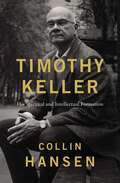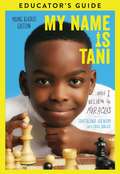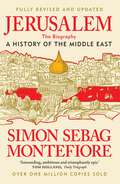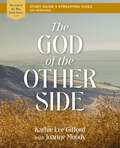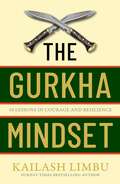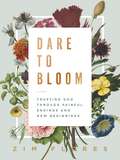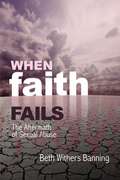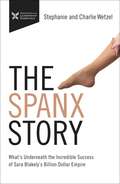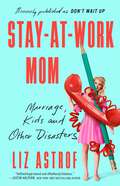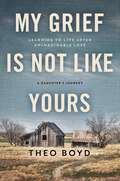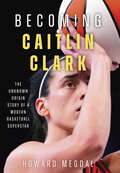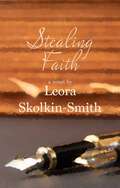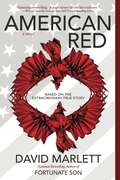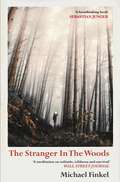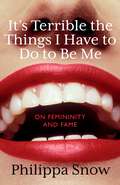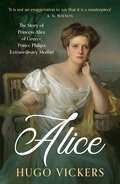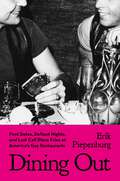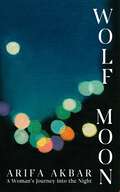- Table View
- List View
Timothy Keller: His Spiritual and Intellectual Formation
by Collin HansenThe untold story of the people, the books, the lectures, and ultimately the God who formed and shaped the life of the late Timothy Keller.Millions have read books and listened to sermons by Timothy Keller. But who impacted his own thinking, and what shaped his spiritual growth and ministry priorities? With full access to Keller's personal notes and sermons—as well as exclusive interviews with family members and longtime friends—Collin Hansen takes readers behind the scenes of one of the 21st century's most influential church leaders.For the first time, Hansen introduces readers to Keller's early years: the home where he learned to tell stories from the trees, the church where he learned to care for souls, and the city that lifted him to the international fame he never wanted.This unique biography will allow you to:Understand the principles and practices that allowed Keller to synthesize so many different influences in a coherent ministry.Take the best of Keller's preaching and teaching to meet emerging challenges in the 21st century.Develop your own historical, theological, and cultural perspectives to shape your leadership. The story of Timothy Keller is the story of his spiritual and intellectual influences, from the woman who taught him how to read the Bible to the professor who taught him to preach Jesus from every text to the philosopher who taught him to see beneath society's surface.
My Name Is Tani Young Readers Edition Educator's Guide
by Tanitoluwa AdewumiMy Name Is Tani Young Readers Edition Educator's Guide is a companion to My Name Is Tani . . . And I Believe in Miracles Young Readers Edition by Tani Adewumi. This guide can be utilized in the classroom, in a home school setting, or by parents seeking additional resources. Ideal for grades 4th-6th.
Jerusalem: The Biography – A History of the Middle East
by Simon Sebag MontefioreThoroughly updated and revised for 2024, JERUSALEM: THE BIOGRAPHY is the history of the Middle East through the lens of the Holy City and the Holy Land, from King David to the wars and chaos of today. The history of Jerusalem is the story of the world: Jerusalem is the universal city, the capital of two peoples, the shrine of three faiths. The Holy City and Holy Land are the battlefields for today's multifaceted conflicts and, for believers, the setting for Judgement Day and the Apocalypse.How did this small, remote town become the Holy City, the 'centre of the world' and now the key to peace in the Middle East? Why is the Holy Land so important not just to the region and its many new players, but to the wider world too? Drawing on new archives and a lifetime's study, Montefiore reveals this ever-changing city and turbulent region through the wars, love affairs and revelations of the kings, empresses, amirs, sultans, caliphs, presidents, autocrats, imperialists and warlords, poets, prophets, saints and rabbis, conquerors and whores who created, destroyed, chronicled, and believed in Jerusalem and the Holy Land. A classic of modern literature, this is not only the epic story of 3,000 years of faith, slaughter, fanaticism, co-existence, power and myth, but also a freshly updated, carefully balanced history of the Middle East, from King David to the new players and powers of the twenty-first century, from the birth of Judaism, Christianity and Islam to the Israel-Palestine conflict and the mayhem of today.This is how today's Middle East was forged, how the Holy Land became sacred and how Jerusalem became Jerusalem - the only city that exists twice - in heaven and on earth.
The God of the Other Side Bible Study Guide plus Streaming Video (God of The Way)
by Kathie Lee GiffordDiscover the incredible lengths God will go to reach those who are lonely, lost, and left out.In this six-session video Bible study (streaming access included), Kathie Lee Gifford and Joanne Moody reveal how Jesus broke through social barriers and reached those on the "other side" whom society had abandoned.This Bible study (part 4 of The God of the Way Study Series) will show you how God draws in the foreigner, the wayward, the paralyzed, and other outcasts as essential parts of the kingdom he&’s building. You'll learn what it means to go with Jesus to "the other side", how it shapes your faith, and how it impacts your daily life in exciting new ways.Each session includes clips from The God of the Way that brings the story of Scripture to life with contemporary orchestral arrangements, powerful narration and visuals.Sessions and video run times:The Other Side (23:00)The Demoniac (24:00)The Samaritan Woman (22:00)The Prodigal Son (22:00)Cornelius and Peter (23:00)The Power of Unity (23:00) This study guide has everything you need for a full Bible study experience, including:The study guide itself—with discussion and reflection questions, video notes, and a leader's guide.An individual access code to stream all video sessions online. (You don&’t need to buy a DVD!)Streaming video access code included. Access code subject to expiration after 12/31/2029. Code may be redeemed only by the recipient of this package. Code may not be transferred or sold separately from this package. Internet connection required. Void where prohibited, taxed, or restricted by law. Additional offer details inside.
The Gurkha Mindset: 10 Lessons in Courage and Resilience
by Captain Kailash LimbuThe Gurkha Mindset distils the wisdom and experiences of a seasoned Gurkha soldier into ten powerful lessons for life and leadership.Drawing from over two decades of service in the British Army, including five tours in Afghanistan and deployments in Bosnia and Sierra Leone, Captain Kailash Limbu shares the core principles that have shaped his journey as a soldier and a man. Through the metaphor of the khukuri, a symbolic and essential tool for every Gurkha, he illustrates how mindset and behaviour are crucial to overcoming challenges, achieving success and leading with honour.Kailash reveals how the disciplined and courageous mindset of the Gurkhas can be applied to everyday life, helping readers manage emotions, foster teamwork, lead effectively and prioritise self-care. Each lesson is rooted in the simplicity and strength of the Gurkha way of life, offering practical insights that are both timeless and adaptable to any context.Whether you seek to enhance your personal life, advance in your career or simply find greater fulfilment, The Gurkha Mindset provides the tools to sharpen your focus, build resilience and embrace life's challenges with a warrior's spirit.
Dare to Bloom: Trusting God Through Painful Endings and New Beginnings
by Zim FloresEither by choice or by circumstance, we all encounter times of starting over. Seasons of hardships, abundance, seeking, and struggle all have a purpose because growth demands change. Dare to Bloom urges us to be both vulnerable and resilient in new seasons of life as we boldly position ourselves for what God has for us next. Serial entrepreneur and author, Zim Flores (neè Ugochukwu), reveals the challenges she's faced and how even her failures have helped shape her sense of purpose.Her parents had big plans for her life. The daughter of Nigerian immigrants, Zim Flores was uprooted from her community as a young girl, marking the beginning of her quest for true identity. Though she experienced unprecedented worldly success as a teenager and young adult, Zim declares that even when we feel pressured by the world around us, our true identity is never at risk.In Dare to Bloom, Zim offers practical and hard-won truths about:How to reclaim your true identityHow to surrender your desired outcomes to GodHow to move forward after broken friendshipsHow to find comfort during your darkest hoursHow to navigate new beginnings with hope for whatever is nextHow to joyfully participate in your own story--even when you don't know what the future holds Dare to Bloom is a powerful gift for readers in times of transition or struggle who need a reminder that their true identity never changes. It empowers those who feel stuck in their current circumstances to follow God obediently into the unknown, finding joy in each new beginning. Inside you'll find:Breathtaking photography from Zim's travelsThoughtful questions for reflection at the end of each chapterZimisms--wisdom-filled phrases from the author When everything changes around us, it can be easy to think that we're only as good as our last success. Though our identities are challenged day by day, Dare to Bloom encourages us to reclaim our identity in God, who is unchanging through it all.
When Faith Fails: The Aftermath of Sexual Abuse
by Beth Withers BanningOn January 24, 2018, Dr. Larry Nassar was sentenced to 40-175 years in federal prison for abusing more than 245 athletes that were under his care spanning 30 years. At his sentencing, Randall Margraves had the opportunity to speak as the father of two of the abuse victims. Riddled with anger and grief, Mr. Margraves did what every parent in the courtroom wanted to do--he lunged at Dr. Nassar after being denied by the judge five minutes alone with him.Statistics of sexual abuse continue to rise in the United States. Sadly, a deviant culture has invaded our shores and stolen the innocence of our children. Kathryn&’s story is only one of the millions of mothers who have had to deal with the repercussions of the sexual abuse of their daughters, and I would like to thank Kathryn and Kara for their bravery in sharing their personal experiences.For parents, it is a never-ending heartache filled with guilt and regret. Hopefully, the journey that God has brought Kathryn and Kara through will assist or enlighten the millions of parents coping with the aftermath of sexual abuse in their families.May you be spared of such devastation, but if not, until parents speak out, the world will never change. When your faith fails, please know that believing again is possible.Beth Withers Banning
The Spanx Story: What's Underneath the Incredible success of Sara Blakely's Billion Dollar Empire (The Business Storybook Series)
by Charlie Wetzel Stephanie WetzelWhat can you learn from one of the most successful companies in the world? The Spanx Story will help you understand and adopt the competitive strategies, workplace culture, and daily business practices that enabled entrepreneur Sara Blakely to dominate the shapewear industry and become a billionaire.Sara Blakely had a problem. She had a beautiful pair of white designer pants hanging in her closet just calling out to her to wear them, even though they accented her least favorite feature: cellulite. After searching high and low for a solution and coming up empty, an idea was born: Spanx.The Spanx Story chronicles Sara&’s journey from long nights researching patent and trademark law, to years of cold shoulders she received from the titans of the pantyhose industry, to the cold call that led to the shelves of Nieman Marcus. It was a long road of incredible hard work and determination that led Spanx to become the iconic brand it is today.Through Sara&’s story, you will learn:How to develop an idea and turn it into a business.How to start a company with very little capital by thinking outside of the box and dedicating every spare moment to your goal.How to recognize when it&’s better to hire a CEO than to be the CEO.How to stay the course and continue to believe in your idea, despite naysayers and going against an industry resistant to innovation.The Spanx Story educates and inspires entrepreneurs and innovators to find the problem for their solutions and persevere through the hard work that goes into building a billion-dollar company.
Stay-at-Work Mom: Marriage, Kids, and Other Disasters
by Liz Astrof&“The parenting genre is never going to be the same&” (Jancee Dunn, author of How Not to Hate Your Husband After Kids) after this candid and hilarious collection of essays on motherhood from the award-winning television comedy writer and producer of 2 Broke Girls and The King of Queens, who swears she loves her kids—when she&’s not hiding from them.Some women feel that motherhood is a calling and their purpose on earth. They somehow manage to make pregnancy look effortless, bring out the beauty in a screaming child, and keep the back seat of their cars as spotless as their kitchens. And then there are women like Liz Astrof—who originally had children because &“everyone else was.&” In this blunt and side-splittingly funny book of essays (previously published as Don&’t Wait Up), Liz Astrof embraces the realities of motherhood (and womanhood) that no one ever talks about: like needing to hide from your kids in your closet, your car, or a yoga class on the other side of town, letting them eat candy for dinner because you just can&’t deal, to the sheer terror of failing them or at the very least losing them in a mall. And sometimes, many times, wondering if the whole parenting thing wasn&’t for you. Perfect for fans of Let&’s Pretend This Never Happened and I Heart My Little A-Holes, Stay-At-Work Mom is a soul-baring and honest look at parenting and relationships for moms who realize that motherhood doesn&’t have to be your entire life—just an amazing part of it.
My Grief Is Not Like Yours: Learning to Live after Unimaginable Loss—A Daughter's Journey
by Theo BoydA daughter's heartbreaking and tragic story of losing her parents—and hope for those walking their own journey through grief.Theo Boyd had always been close to her parents. Her father was a Texas peanut farmer, rancher, and preacher; her mother, deaf from a young age, was the glue that held them all together. Then one summer day in 2019, everything changed when Theo&’s mother died in a tragic accident on their family farm. As Theo began to process this loss, her marriage started to unravel, adding another painful layer to her grief. Meanwhile, Theo continued to care for her father who was shaken to his core by the tragedy. Nothing could erase the agony he felt from losing his love and soulmate of over fifty years, and one night he chose to escape his pain by ending his life. Theo suddenly had to learn to live without the two people who were her constant love and support—her parents. In My Grief Is Not Like Yours, Theo gives an unforgettable account of how quickly life can turn to grief. Beautifully woven, this book is threaded with memories and raw emotions that are seldom discussed. Theo shows readers how she endured the unimaginable. She walks beside anyone navigating through their grief, helping them feel less alone and guiding them to hope and healing. &“We are all unique, in life and in death. We are born, we live, we die, and we grieve, but my grief is not like yours.&” —Theo Boyd
Doppelganger: A Trip into the Mirror World
by Naomi Klein#1 NATIONAL BESTELLER • Winner of the 2024 Women's Prize for Non-Fiction • Winner of the 2024 Vine National Canadian Jewish Book Award for Non-Fiction • Finalist for the 2024 National Book Critics Circle Award for Criticism • Shortlisted for the 2024 Hubert Evans Non-Fiction Prize • A New York Times Notable Book of 2023 • Vulture&’s #1 Book of 2023 • A Guardian Best Ideas Book of 2023What if you woke up one morning and found you'd acquired another self—a double who was almost you and yet not you at all? What if that double shared many of your preoccupations but, in a twisted, upside-down way, furthered the very causes you'd devoted your life to fighting against?Not long ago, Naomi Klein had just such an experience—she was confronted with a doppelganger whose views she found abhorrent but whose name and public persona were similar enough to her own that many people confused her for the other. For a vertiginous moment, she lost her bearings. And then she got interested, in a reality that seems to be warping and doubling like a digital hall of mirrors. It&’s happening in our politics as New Age wellness entrepreneurs turned anti-vaxxers find common cause with fire-breathing far right propagandists (all in the name of protecting &“the children&”). It&’s happening in our culture as AI gobbles up music, paintings, fiction and everything in between and spits out imitations that threaten to overtake the originals. And it&’s happening to many of us as individuals as we create digital doubles of ourselves, filtered and curated just so for all the other duplicates to see. An award-winning journalist, bestselling author, public intellectual and activist, Naomi Klein writes books that orient us in our time. She has offered essential accounts of what branding, austerity, and climate profiteering have done to our societies and souls. Now, as liberal democracies teeter on the edge, Klein takes aim at absurdist authoritarianism, using a keen sense of the ridiculous to face the doubles that haunt us. Part tragicomic memoir, part chilling reportage and cobweb-clearing analysis, Doppelganger invites readers on a wild ride, smashing through the mirror world, charting a path beyond despair towards true solidarity.
Becoming Caitlin Clark: The Unknown Origin Story of a Modern Basketball Superstar
by Howard MegdalCombining modern reportage with historical revelations, a multifaceted portrait of Caitlin Clark's game-changing superstardom and the cultural foundation it was built upon. <P><P> Caitlin Clark has established herself as one of the global faces of the WNBA and has ignited popular interest in women's sports. Her ascent to dominance and international celebrity represents the continuation of a surprisingly deep lineage for women's basketball in the state of Iowa where Clark was born and raised, and where she wrote her name throughout the NCAA history books as a Hawkeye. <P><P> Spanning 100 years and several generations, Becoming Caitlin Clark traces the arc between the revered women who played the wildly popular game of 6-on-6 basketball in the 1920s and Clark in the 2020s, examining her fame and style of play in the context of her predecessors, while telling the story of the basketball-loving community that rallied behind her in college and beyond. <P><P> Howard Megdal's storytelling incorporates in-depth conversations with Clark; her coach Lisa Bluder; her Iowa teammates, including WNBA star Kate Martin; the top assistant coach at Iowa, Jan Jensen; the Caitlin Clark of the 1970s, Molly Bolin; vital figures in the growth of Iowa basketball like C. Vivian Stringer and Jolette Law; and even Jensen's grandmother Dorcas Andersen, who scored 89 points in the Iowa state tournament in 1921 and kept journals as she did so, brought to light here for the first time. From rural auditoriums to the Indiana Fever's Gainbridge Fieldhouse, this intimate yet kaleidoscopic perspective on the modern game and its newest icon makes this an essential read for WNBA and college basketball fans.
Stealing Faith
by Leora Skolkin-SmithAllegra Gordon knew there was much she could learn from Faith Hale. From the moment she met the esteemed writer and feminist icon on the campus of New York's Abigail Stone College, Allegra understood that Faith would be a force in her life, one that would wrench the best work from her and encourage her to lay her soul bare. The relationship that evolved would simultaneously be the most liberating and most shattering Allegra ever encountered. And it would change both women in profound ways. From political rallies in the early seventies to soaring tributes at the turn of the twenty-first century, from confidences betrayed to liberties taken to freedoms denied, from a cottage in Maine to stone buildings in Manhattan to a farmhouse in Vermont, here is a story of women's lives unfurled and of a friendship at once impossible and eternal.
American Red: A Novel
by David MarlettThe Great American Century begins, the modern world roars to life, Capitalists flaunt greed and seize power, Socialists and labor unions flex their violent will, and an extraordinary true story of love and sacrifice unfolds.The men and women of American R ed are among the most fascinating in American history. When, at the dawn of the 20th century, the Idaho governor is assassinated,blame falls on &“Big Bill&” Haywood, the all-powerful, one-eyed boss of the Western Fed- eration of Miners in Denver. Close by, his polio-crippled wife, Neva, struggles with her wavering faith, her love for another man, and her sister's affair with her husband.New technologies accelerate American life, but justice lags behind. Private detectives, bat- tling socialists and unions on behalf of wealthy capitalists, will do whatever it takes to seeHaywood hanged. The scene is set for bloodshed, from Denver to Boise to San Francisco.America's most famous attorney, Clarence Darrow, leads the defense—a philandering U.S. senator leads the prosecution—while the press, gunhands, and spies pour in.Among them are two idealists, Jack Garrett and Carla Capone—he a spy for the prosecu- tion, she for the defense. Risking all, they discover truths about their employers, about themselves and each other, and what they'll sacrifice for justice and honor—and for love.
The Stranger in the Woods: The extraordinary story of the last true hermit
by Michael Finkel*THE NEW YORK TIMES BESTSELLER* Could you leave behind all that you know and live in solitude for three decades? This is the extraordinary story of the last true hermit - Christopher Knight. 'This was a breath-taking book to read and many weeks later I am still thinking about the implications for our society and - by extension - for my own life' Sebastian Junger, bestselling author of The Perfect Storm 'A wry meditation on one man's attempt to escape life's distractions and look inwards, to find meaning not by doing, but by being' Martin Sixsmith, bestselling author of Philomena and Ayesha's Gift 'Not all heroes wear capes. My latest one is a man called Christopher Knight – a silent idol for anyone who has felt the urge to just sack it all off and live the life of a hermit' Lucy Mangan, Stylist 'An extraordinary story about solitude, community, identity and freedom' Guardian 'A meditation on solitude, wildness and survival. It is also, unexpectedly, a tribute to the joys of reading' The Wall Street Journal In 1986, twenty-year-old Christopher Knight left his home in Massachusetts, drove to Maine, and disappeared into the woods.He would not speak to another human being until three decades later when he was arrested for stealing food. Christopher survived by his wits and courage, developing ingenious ways to store food and water in order to avoid freezing to death in his tent during the harsh Maine winters. He broke into nearby cottages for food, clothes, reading material and other provisions, taking only what he needed. In the process, he unwittingly terrified a community unable to solve the mysterious burglaries. Myths abounded amongst the locals eager to find this legendary hermit. Based on extensive interviews with Knight himself, this is a vividly detailed account of his secluded life and the challenges he faced returning to the world. The Stranger in the Woods is a riveting story of survival that asks fundamental questions about solitude and what makes for a good life.Above all, this is a deeply moving portrait of a man determined to live life his own way.
It's Terrible the Things I Have to Do to Be Me: 'A brutal and brilliant study of female celebrity' Megan Nolan, Telegraph
by Philippa Snow'Turns female celebrity inside-out. One of the most enjoyable books of the year' Nicole Flattery, author of Show Them A Good Time'A brutal and brilliant study of female celebrity ... a joy to read, fizzing with intelligence' Megan Nolan, Telegraph---------------------------------------------------------------------------------------How does an icon become an icon? How did Anna Nicole Smith model herself on Marilyn Monroe? What connects Lindsay Lohan with Elizabeth Taylor? How is self-made beauty Pamela Anderson like trans bond girl Caroline 'Tula' Cossey?In a series of interconnected essays about pairs of famous women, award-nominated essayist and art critic Philippa Snow explores the echoes and connections between a constellation of female stars and lays bare the artful and gruelling demands of femininity - from the golden age of Hollywood to the Instagram era. Full of the fascinating, entertaining and lurid details you might expect from the lives of mega-famous celebrities, dissected with icicle-sharp intelligence and rendered in stylish, flamboyant prose, Philippa Snow's first full-length non-fiction work is a radically insightful book about the complex meanings and layers of femininity in a male-dominated world.
My Cousin Maria Schneider
by Vanessa Schneider"Lovingly written" Deborah Harry"An exquisite portrait of a tragic heroine" Violaine HuismanA spare, heartbreaking memoir and tribute to Maria Schneider, the 1970s movie starlet who catapulted to fame in the controversial film Last Tango in Paris-only to live the rest of her life plagued by scandal-as told from the perspective of her adoring younger cousin.The late French actress Maria Schneider is perhaps best known for playing Jeanne in the provocative film Last Tango in Paris, directed by Bernardo Bertolucci and released to international shock and acclaim in 1972. It was Maria's first major role, alongside film legend Marlon Brando, when she was barely eighteen years old. The experience would haunt her for the rest of her life, traumatizing her and sparking a tabloid firestorm that only ceased when she began to retreat from the public eye nearly two decades later.To Maria's much younger cousin, Vanessa Schneider, Maria was a towering figure of another kind-a beautiful and fearsome fixture in Vanessa's childhood, a rising star turned pariah whose career and struggles with addiction won the family shame and pride in equal measure. Here, Vanessa recounts the challenges of their overlapping youths and fraught adulthood and reveals both the tragedy and inevitability of Maria's path in a family plagued by mental illness and in a society rife with misogyny.Unsentimental and suffused with deep love, My Cousin Maria Schneider is the story of a talented artist and the cousin who admired her, and of exploitation and how its lingering effects can reverberate through a lifetime.
Don't Let it Break You, Honey: A Memoir About Saving Yourself
by Jenny EvansCast in a feature film at the age of eighteen, Jenny Evans was on the cusp of something extraordinary; a route out of her hometown, a future of promise. But the new world she was exploring crumbled around her when she was assaulted at a party by a high-profile figure.Jenny reported this crime to the police when she became aware of other allegations of violence against The Famous Man. Shortly after doing so, details of what she had experienced were printed in a tabloid newspaper.Jenny trained as a journalist herself to try to find out how this happened. In the aftermath of devastation, she picked up the pieces and fought back against the systems that caused her harm. Her investigation helped expose the jaw-dropping press abuse and police corruption we now call the 'phone-hacking scandal'. Now training as a lawyer, Jenny is still working to fight for justice in a system that so horrifically fails its victims.Don't Let it Break You, Honey is a reckoning: a personal, fiercely compelling account of power - who holds it, who wields it, who is silenced in the process. It asks urgent questions about fame, justice, and the institutions we have no choice but to trust, while offering something even more profound: hope.Because this is, above all, a story about resilience. About finding your voice when the world wants to silence you. And refusing to let them win.
Alice: The Story of Princess Alice of Greece, Prince Philip's Extraordinary Mother
by Hugo VickersThe remarkable, moving story of Prince Philip's mother by eminent biographer Hugo Vickers, updated in this new edition - for fans of Kingmaker and The Lives and Deaths of the Princesses of Hesse'Gripping. Hugo Vickers has pulled off an extraordinary feat in describing the life - in many ways tragic - of Princess Andrew of Greece. It is not an exaggeration to say that this is a masterpiece.' - A. N. Wilson'Vickers tells this story with a sure touch and an expertise that only he can command' SUNDAY TIMES'A sympathetic, piquant and well-defined portrait of a spirited woman' LITERARY REVIEW'Sympathetic yet free of pathos, Vickers's life celebrates an unusual and fascinating woman' KIRKUS--------Princess Alice, mother of Prince Phillip, was something of a mystery figure even within her own family. Profoundly deaf, she was born at Windsor Castle in the presence of her great-grandmother, Queen Victoria, and brought up in England, Darmstadt, and Malta.In 1903 she married Prince Andrew of Greece and Denmark, and from then on her life was overshadowed by wars, revolutions, enforced periods of exile. Further crisis hit when, at the age of forty-five, she was removed from her family and placed in a sanatorium in Switzerland, where she was pronounced a paranoid schizophrenic. As her stay in the clinic became prolonged, there was a time where it seemed she might never walk free again.Yet she recovered.Illuminating and enthralling, eminent biographer Hugo Vickers's account of her life is as tumultuous and extraordinary as the times she lived through.
Dining Out: First Dates, Defiant Nights, and Last Call Disco Fries at America's Gay Restaurants
by Erik PiepenburgFrom a New York Times journalist, a culinary tour of gay restaurants—their history, and how they evolved as a space of safety and celebration for the LGBTQ+ community—full of joy, sex, sorrow, activism, and nostalgia.Dining Out explores how gay people came of age, came out, and fought for their rights not just in gay bars or the streets, but in restaurants. From cruisy urban cafeterias of the 1920s to mom-and-pop diners that fed the Stonewall generation to the intersectional hotspots of the early 21st century. Using archival material, original reporting and interviews, and first-person accounts, Erik Piepenburg explores how LGBTQ restaurants shaped and continue to shape generations of gay Americans. Through the eyes of a reporter and the stomach of a hungry gay man, Dining Out examines the rise, impact and legacies of the nation's gay restaurants past, present, and future, connecting meals with memories. Hamburger Mary&’s, Florent, a suburban Denny&’s queered by kids: Piepenburg explores how these and many other gay restaurants, coffee shops, diners, and unconventional eateries have charted queer placemaking and changed the modern LGBTQ civil rights movement for the better.
It's Terrible the Things I Have to Do to Be Me: 'A brutal and brilliant study of female celebrity' Megan Nolan, Telegraph
by Philippa Snow'Turns female celebrity inside-out. One of the most enjoyable books of the year' Nicole Flattery, author of Show Them A Good Time'A brutal and brilliant study of female celebrity ... a joy to read, fizzing with intelligence' Megan Nolan, Telegraph---------------------------------------------------------------------------------------How does an icon become an icon? How did Anna Nicole Smith model herself on Marilyn Monroe? What connects Lindsay Lohan with Elizabeth Taylor? How is self-made beauty Pamela Anderson like trans bond girl Caroline 'Tula' Cossey?In a series of interconnected essays about pairs of famous women, award-nominated essayist and art critic Philippa Snow explores the echoes and connections between a constellation of female stars and lays bare the artful and gruelling demands of femininity - from the golden age of Hollywood to the Instagram era. Full of the fascinating, entertaining and lurid details you might expect from the lives of mega-famous celebrities, dissected with icicle-sharp intelligence and rendered in stylish, flamboyant prose, Philippa Snow's first full-length non-fiction work is a radically insightful book about the complex meanings and layers of femininity in a male-dominated world.
Wolf Moon: A Woman's Journey into the Night
by Arifa Akbar'A beautifully written combination of personal reflection and broader thought . . . at once atmospheric and touching' Louise Doughty, author of Apple Tree Yard'Had me entranced from start to finish . . . an absolute joy'Lucy Atkins, author of Windmill Hill'A deft, rich and intimate exploration of darkness in all its varied guises'Annabel Abbs, author of Sleepless'Truthful, lyrical and unforgettable'Yasmin Alibhai-BrownThe night is a time of darkness and nightmares, fear and vulnerability, especially for women. And, yet, it is another world, full of beauty and possibility, too.After the sun goes down, insomnia and sleep paralysis do threaten. But some have always walked the nocturnal landscapes, with more or less confidence. Others have worked, night shifts and hidden night work: nurses, security guards, sex workers. And some have found solace in the darkness, from queer rave culture to religious pre-dawn traditions.From dusk through to day, Arifa Akbar elegantly explores how the night shapes our bodies, minds and cultures. A personal and artistic journey from fear and into hope, Wolf Moon embraces the dark before bringing us, once more, into the light.Praise for Consumed:⭐ 'Beguiling . . . this one stands out for its eccentricity and elegiac splendour' Diana Evans, Guardian⭐ 'Moving, engrossing, elegantly written' Sunday Times⭐ 'I have rarely read a memoir with such a combination of powerful, tender feelings and cool-headed analysis' Mail on Sunday
Alice: The Story of Princess Alice of Greece, Prince Philip's Extraordinary Mother
by Hugo VickersThe remarkable, moving story of Prince Philip's mother by eminent biographer Hugo Vickers, updated in this new edition - for fans of Kingmaker and The Lives and Deaths of the Princesses of Hesse'Gripping. Hugo Vickers has pulled off an extraordinary feat in describing the life - in many ways tragic - of Princess Andrew of Greece. It is not an exaggeration to say that this is a masterpiece.' - A. N. Wilson'Vickers tells this story with a sure touch and an expertise that only he can command' SUNDAY TIMES'A sympathetic, piquant and well-defined portrait of a spirited woman' LITERARY REVIEW'Sympathetic yet free of pathos, Vickers's life celebrates an unusual and fascinating woman' KIRKUS--------Princess Alice, mother of Prince Phillip, was something of a mystery figure even within her own family. Profoundly deaf, she was born at Windsor Castle in the presence of her great-grandmother, Queen Victoria, and brought up in England, Darmstadt, and Malta.In 1903 she married Prince Andrew of Greece and Denmark, and from then on her life was overshadowed by wars, revolutions, enforced periods of exile. Further crisis hit when, at the age of forty-five, she was removed from her family and placed in a sanatorium in Switzerland, where she was pronounced a paranoid schizophrenic. As her stay in the clinic became prolonged, there was a time where it seemed she might never walk free again.Yet she recovered.Illuminating and enthralling, eminent biographer Hugo Vickers's account of her life is as tumultuous and extraordinary as the times she lived through.
Wolf Moon: A Woman's Journey into the Night
by Arifa Akbar'A beautifully written combination of personal reflection and broader thought . . . at once atmospheric and touching' Louise Doughty, author of Apple Tree Yard'Had me entranced from start to finish . . . an absolute joy'Lucy Atkins, author of Windmill Hill'A deft, rich and intimate exploration of darkness in all its varied guises'Annabel Abbs, author of Sleepless'Truthful, lyrical and unforgettable'Yasmin Alibhai-BrownThe night is a time of darkness and nightmares, fear and vulnerability, especially for women. And, yet, it is another world, full of beauty and possibility, too.After the sun goes down, insomnia and sleep paralysis do threaten. But some have always walked the nocturnal landscapes, with more or less confidence. Others have worked, night shifts and hidden night work: nurses, security guards, sex workers. And some have found solace in the darkness, from queer rave culture to religious pre-dawn traditions.From dusk through to day, Arifa Akbar elegantly explores how the night shapes our bodies, minds and cultures. A personal and artistic journey from fear and into hope, Wolf Moon embraces the dark before bringing us, once more, into the light.Praise for Consumed:⭐ 'Beguiling . . . this one stands out for its eccentricity and elegiac splendour' Diana Evans, Guardian⭐ 'Moving, engrossing, elegantly written' Sunday Times⭐ 'I have rarely read a memoir with such a combination of powerful, tender feelings and cool-headed analysis' Mail on Sunday
No Obvious Distress: A John Murray Original
by Amanda Quaid'Striking, surprising, and technically excellent, the poems resonate way beyond their endings' Roger Robinson'Deft, daring, devastating and delightful' Pádraig Ó Tuama'Astonishing. These poems glimmer with a white-hot beauty that is hard won, and that sings' Sarah RuhlPatient is a normal appearing woman in no obvious distress.On an ordinary day, out with her three-year-old in the park, Amanda Quaid received a life-changing call - the back pain she had been living with for years was actually a rare and aggressive form of cancer. In an instant, life became a series of sterile rooms, medical charts and body-altering treatments which completely upend Amanda's marriage, work and family life as she knows it.Poetry became a lifeline for Amanda, a form to organize the chaos and pain of day-to-day life into order and beauty. In inventive and arresting poems that explore desire, marriage, motherhood and mortality, No Obvious Distress is a powerful memoir-in-verse about Amanda's unique experience. But it is also a tender, witty and universal collection that asks how we can continue to live and love in times of uncertainty.
